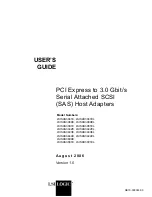
Fabric OS 6.2 administrator guide
33
To skip a single prompt press
Enter
. To skip all of the remaining prompts press
Ctrl-C.
login:
admin
Password:
Please change your passwords now.
Use Control-C to exit or press 'Enter' key to proceed.
for user - root
Changing password for root
Enter new password:
********
Password changed.
Saving password to stable storage.
Password saved to stable storage successfully.
Please change your passwords now.
for user - factory
Changing password for factory
Enter new password:
********
Password changed.
Saving password to stable storage.
Password saved to stable storage successfully.
Please change your passwords now.
for user - admin
Changing password for admin
Enter new password:
********
Password changed.
Saving password to stable storage.
Password saved to stable storage successfully.
Please change your passwords now.
for user - user
Changing password for user
Enter new password:
********
Password changed.
Saving password to stable storage.
Password saved to stable storage successfully.
switch:admin>
The Ethernet interface on your switch
You can use DHCP (Dynamic Host Configuration Protocol) for the Ethernet network interface configuration.
The Ethernet (network) interface provides management access, including direct access to the Fabric OS
CLI, and allows other tools, such as Web Tools, to interact with the switch.
You can continue to use a static Ethernet addressing system or allow the DHCP client to automatically
acquire Ethernet addresses. Configure the Ethernet interface IP, subnet mask, and gateway addresses in
one of the following sections:
•
”
Static Ethernet addresses
” on page 35
•
”
DHCP activation
” on page 35
When you change the Ethernet interface settings, open connections such as SSH or Telnet may be
dropped. Reconnect using the new Ethernet IP information or change the Ethernet settings using a console
session through the serial port to maintain your session through the change. You must connect through the
serial port to set the Ethernet IP address if the Ethernet network interface is not configured already. See
”
Connecting to Fabric OS through the serial port
” on page 31 for details.
Virtual fabrics and the Ethernet interface
IPFC allows management on switches, directors, and enterprise-class platforms using the Ethernet
interfaces. On each director and enterprise-class platform there are two Ethernet interfaces that are
associated with the active CP. In a Virtual Fabric, the IPFC network interface is associated with the chassis
and can be assigned its own IPv4 and IPv6 address.
Summary of Contents for A7533A - Brocade 4Gb SAN Switch Base
Page 1: ...HP StorageWorks Fabric OS 6 2 administrator guide Part number 5697 0016 Edition May 2009 ...
Page 24: ...24 ...
Page 99: ...Fabric OS 6 2 administrator guide 99 ...
Page 100: ...100 Managing user accounts ...
Page 118: ...116 Configuring standard security features ...
Page 164: ...162 Configuring advanced security features ...
Page 234: ...232 Installing and maintaining firmware ...
Page 268: ...266 Administering advanced zoning ...
Page 284: ...282 Configuring Enterprise class platforms ...
Page 292: ...290 Routing traffic ...
Page 294: ...292 Interoperability for merged SANs ...
Page 302: ...300 Configuring the Distributed Management Server ...
Page 334: ...332 iSCSI gateway service ...
Page 340: ...338 Administering NPIV ...
Page 407: ...Fabric OS 6 2 administrator guide 405 ...
Page 408: ...406 Using the FC FC routing service ...
Page 438: ...434 Administering extended fabrics ...
Page 460: ...456 Administering ISL trunking ...
Page 516: ...512 FICON fabrics ...
Page 526: ...522 Configuring and monitoring FICON Extension Services ...
Page 540: ...536 Configuring the PID format ...
Page 544: ...540 Understanding legacy password behavior ...
Page 546: ...542 Mixed fabric configurations for non merge SANs ...
Page 550: ...546 Migrating from an MP Router to a 400 MP Router ...
Page 558: ...554 Inband Management ...
Page 572: ...568 ...
















































